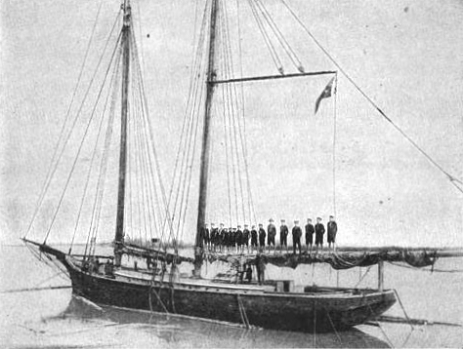Schooner Casco Has Adventurous Career
The Sacramento Union – NOME, Alaska, Sunday Nov. 7, 1919 (by mail) — The romantic and adventurous career of the old Robert Stevenson schooner Casco as a yacht, smuggler, sealer and gold seeker came to an end when she ploughed on to the rocks at King island, north of Nome, recently while hurrying south from Siberian gold fields in an attempt to beat the oncoming winter ice.

The Casco was built in San Francisco about thirty years ago as a yacht for a Dr. Merritt, of San Francisco, a friend of Robert Louis Stevenson, the author. Merritt, according to local records, took Stevenson and started west in 1888 on a circle of the globe in an attempt to restore the author’s failing health. When Stevenson decided to remain in the South Seas, Dr. Merritt sold the Casco. Next the Casco played the part of an opium smuggler in Hawaiian and Oriental waters. Revenue officers chased her through Asiatic and American seas, yet she continued her work for several years.

Sealing was her next task and she was sent north into the stormy Pacific waters around Alaska. In June of this year the Casco left San Francisco carrying a company of argonauts to an unnamed destination on the north Siberian coast, 1000 miles east of Behring Straits. They had been told, it is believed, by an old whaler that gold could be found in the Kolyma river country of Siberia. Encountering one of the earliest winters recorded in Arctic history, she finally reached North Cape, the farthest north point reached by an American boat this year. On the return voyage she was thrown on to King island where she now lies a hopeless wreck.
*Noteworthy
1703 – The Great Storm of 1703, the greatest windstorm ever recorded in the southern part of Great Britain, makes landfall. Winds gust up to 120 mph, and 9,000 people die. The Great Storm of 1703 was a destructive extratropical cyclone that struck central and southern England on 26 November 1703 (7 December 1703 on the Julian calendar in use today). High winds caused 2,000 chimney stacks to collapse in London, and winds damaged the New Forest, which lost 4,000 oaks. Ships were blown hundreds of miles off-course, and over 1,000 seamen died on the Goodwin Sands alone. News bulletins of casualties and damage were sold all over England – a novelty at that time. The Church of England declared that the storm was God’s vengeance for the sins of the nation. Daniel Defoe thought it was a divine punishment for poor performance against Catholic armies in the War of the Spanish Succession.
1787 – Delaware becomes the first state to ratify the United States Constitution.
1941 – Imperial Japanese Navy with 353 planes attack US fleet at Pearl Harbour Naval Base, Hawaii, killing 2,403 people.
1963 – Instant replay makes its debut during the Army-Navy football game in Philadelphia, Pennsylvania, United States.
